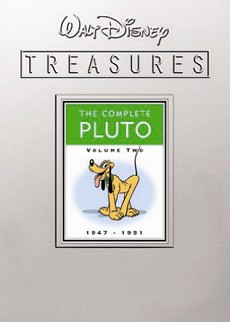DISC 2
The second disc gives us Leonard Maltin once again in a three-minute-long introduction that discusses the various stories and settings allowed for Pluto cartoons, along with the variety of characters that make their way into the shorts. He also makes sure to point out vital people behind the scenes of the Pluto cartoons, like regular Pluto short director Charles "Nick" Nichols, and notable story men like Dick Kinney, Milt Schaeffer, and even Mouseketeer Roy Williams.
Disc 2 contains the final 9 Pluto shorts in both alphabetical and chronological listings (with "play all' again only available for the chronological option). Four shorts can be found in the "From the Vault" section. In addition to these thirteen shorts, two more appear in the bonus materials, as they are Figaro cartoons.
THE SHORTS
 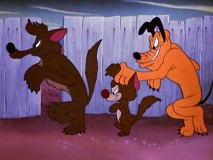 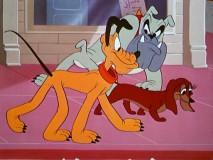
Camp Dog (1950) (7:04)
The coyote and son of Sheep Dog return and this time they're after Pluto's food supply during a camping trip. Pluto stops them several times, but the mess left behind gets him in trouble, prompting him to run off with the coyote and son.
Food For Feudin' (1950) (7:04)
Chip 'N Dale have finished gathering their acorns in a tree, but Pluto tries to hide his bone in there, resulting in acorns spilling everywhere. The precocious chipmunks decide to have fun with Pluto and with the help of some gardening gloves, play ball with him while returning the nuts to the tree.
Pests of the West (1950) (6:45)
Coyote and Son return once again, this time trying to invade a henhouse in the west. Naturally, Pluto's there to stop them. At one point, he fails to realize their presence in his own doghouse, but eventually he tricks them into running away.
Pluto and the Gopher (1950) (6:26)
Taking a nap in Minnie's yard, Pluto gets interrupted by a gopher who enjoys eating flowers. He attempts to capture the gopher, but ends up ruining poor Minnie's flowers instead. The action moves inside as Pluto chases the gopher around the house.
Pluto's Heart Throb (1950) (6:54)
Dinah the Dachshund, one of two girlfriends created for Pluto (Fifi the Peke was an earlier one), appears in her fourth of five Pluto shorts. In this romantic episode of the Pluto and Dinah chronicles, Pluto realizes Dinah's also being pursued by Butch, and the two male dogs vie for her affections.
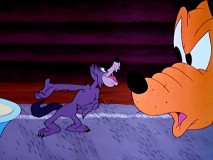  
Primitive Pluto (1950) (6:57)
Pluto is visited by his "Primitive Instinct", who is disappointed in his domesticity, from his dog toys to his flat teeth to his milk toast supper. He convinces him to try life out in the wild. Naturally, the results are bad as Pluto cannot howl like a wild dog, and can't even hold his own when facing a little rabbit.
Puss Cafe (1950) (7:07)
Similar to many Pluto versus Cats shorts, two strays sneak into Pluto's backyard via a hole in the brick wall in an attempt to catch some fish and other small animals in the yard. Pluto stops them several times, and chases them out entirely before running into their much larger mother cat.
Wonder Dog (1950) (6:50)
Dinah the Dachshund makes her fifth and final appearance as Pluto's girlfriend, this time ignoring him for a circus dog named Prince. Pluto attempts to restore her affections by setting up a circus of his own in a junk yard, fighting off Butch the pit bull and impressing Dinah with his various abilities as a show dog.
Cold Storage (1951) (6:51)
A crane takes over Pluto's doghouse in order to keep warm in the winter. Pluto doesn't realize this, until it gets rather fishy that every time he tries to enter his house, it gets up and walks away. Pluto then sees the crane's legs and beak, and attempts to drive him out.
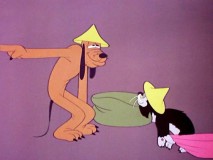 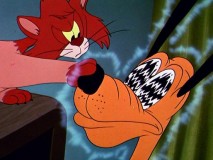 
FROM THE VAULT
In addition to his disc intro, he provides an unskippable one for the "From the Vault" section, explaining the context within the shorts and naturally how times have changed and what was acceptable then is frowned upon now.
Opting to view four shorts from the Vault, Leonard Maltin will first chime in with his unskippable minute-long introduction explaining not only the then-acceptable stereotypes and racial instances, but also the rampant violence in a couple of the shorts. Maltin puts these shorts in context for today's audience, and in a sense apologizes for the closed-mindedness of yesteryear.
Cat Nap Pluto (1948) (6:35)
A hyper little Figaro wishes to play, but Pluto would rather take a nap after being out all night. Constantly being awakened by Figaro, Pluto envisions a "Japanese Sandman" putting him to sleep, which is as far as the racial stereotypes go in this short.
Cold Turkey (1951) (6:58)
A cat similar to the one seen in Puss-Cafe is now a house pet with Pluto, as they drool over a turkey seen on the television. The two search for it around the house, before finding it in the refrigerator. This cartoon gets a vault status due to its extreme violence, such as Pluto's accidental electrocution and his attempts at heating up the cat inside the television.
Plutopia (1951) (7:06)
Mickey and Pluto visit Camp Utopia, the Sportsman's Utopia, but unfortunately, this utopia doesn't apply to dogs. A cat teases Pluto's restrictions, and as they sleep, Pluto has a bizarre (yet fascinating) dream sequence, where the cat is a servant to him in a place called Plutopia. What makes this short a vaulted one is the aspect in which Pluto gets rewarded with food whenever he tortures the cat.
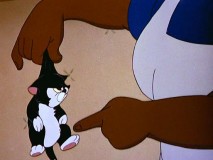 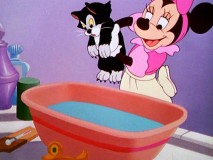 
BONUS SHORTS
Since Figaro's animated shorts canon is quite lean, it was decided to include the three Figaro-only shorts with The Complete Pluto, Volume Two. Their inclusion is a welcome one, as Figaro shared a few cartoons with Pluto and is quite a popular little kitty.
Figaro & Cleo (1943) (8:24)
Accessible either from the Vault page or from the Figaro menu, this short features an infamous Mammy Two-Shoes who is fluent in Ebonics. The short focuses mainly on Figaro causing trouble and making messes that the mammy has to clean up along with his attempts to catch Cleo for supper.
Bath Day (1946) (6:39)
If there's one things cats hate more than dogs, it's baths. Unfortunately, it's time for Figaro's, and Minnie goes all out with bubbles, some perfume, and a little red bow. The other cats laugh at him, a fight gets him dirtier than before, and it's back into the bathtub once again.
Figaro & Frankie (1947) (6:53)
After mistakenly believing that Figaro ate the canary Frankie, Minnie banishes him outside. However, a run-in with Butch scares Figaro back inside, where he watches Frankie be terrorized by the pit bull. After a few prompts from his conscience, Figaro decides to save Frankie, and Minnie welcomes both back.
VIDEO & AUDIO
It is exceptionally pleasing to see that not only have there been actual restoration done for these shorts, but they've also worked on cleaning up the picture and providing richer colors. Presented in their original 1.33:1 fullscreen aspect ratio, video quality for these shorts are on the favorable end of the spectrum between disappointing to outstanding. It should be noted, however, that a few of the early shorts are riddled with flecks and scratches; Mail Dog, the first in the set, is one of the biggest offenders), while Pluto's Purchase hardly has any. The latter does exhibit some oversaturation of colors at times, at least compared to other shorts. Also, a couple shorts like Rescue Dog and Camp Dog look darker and murkier than others, though in some cases it may have been the animator's intentions. And comparing the video for Food for Feudin' from its earlier appearance on a Classic Cartoon Favorites disc, it's apparent that a new superior transfer was used. All in all, the quality here is quite exceptional and better than last year's Treasures.
Audio is a standard Dolby Digital Mono, and is particularly easy on the ears. Since Pluto barely speaks, most of what we'll hear is music and sound effects, with the occasional bark or woof thrown in. It's fairly balanced and easy to understand, and matches the picture nicely.
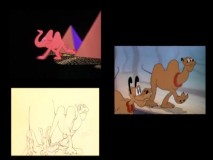 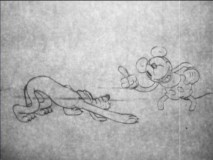 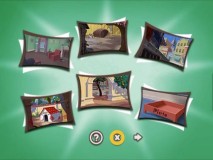
BONUS FEATURES
Four substantial bonus features can be found on the first disc, and are divided into two sections. The first section is Master Class, which offers two featurettes and a "play all" option. The first featurette, entitled "Randy Cartwright Discusses 'Bone Trouble'" (14:43),  |
seems like a video commentary on the 1940 Pluto short. At times, Cartwright will pause or slow down playback, letting the video to a split-screen of him and the short, as he points out some animation techniques or unknown trivia within the short. Some pencil animation is seen a few times as well.
In the second featurette, "Andreas Deja discusses 'Hawaiian Holiday'" (9:07) in the same style that Cartwright does, commenting upon the animation of the short and pointing out or narrating certain parts on the screen. Deja is not quite as trigger-happy on the remote control as Cartwright is, and his featurette focuses a lot with split-screen comparisons of not only pencil animation, but character sketches and background paintings. Both of these pieces are quite interesting, as they blend the concepts of audio commentaries, split-screen comparisons, and general appreciation into rather innovative and unique featurettes.
The second section, Pluto's Process also contains a "play all" option (shouldn't that be "Play Both"?) and offers two different looks at one cartoon, Pluto's Judgement Day, (8:15). "Deconstruction of Pluto's Judgement Day" offers split-and-multi-screen comparisons of the entire short. In addition to the final color animation, the screen often features a look at various background sketches, pencil animation, even some alternate animation. The second featurette provides the entire short in pencil test animation.
On the second disc, bonuses are limited to galleries and shorts. The two bonus shorts are from the lean selection of Figaro-headlined shorts and discussed above. In addition to these shorts, three galleries are provided on disc two. The first is "Pluto Backgrounds" (20 stills) and contains various background pieces from a variety of Pluto cartoons. "Pluto in Progress" (114 stills) is the largest gallery and provides wide variety of concept art, character design sheets, other sketches that give a look at the different styles of drawing and animating Pluto. Finally, "Pluto Published" (50 stills) offers a nice selection of Pluto comics, books, magazine covers and articles, children's records, and even prints of the weekly Sunday comics near the end of the gallery. Each gallery offers thumbnail menus, most with six stills per page.
Both discs offer static 4x3 menus with a bone for the cursor icon in Disc One, and a paw print as the cursor icon on Disc Two. Music is lively and upbeat, save for the shorts listing pages, and feature stills of Pluto, with Figaro getting some recognition on Disc Two's bonus page.
 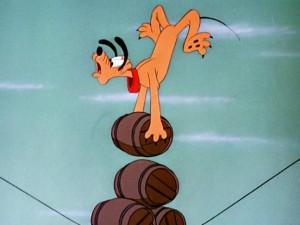
CLOSING THOUGHTS
Disney shorts are not meant to be viewed in quick succession, and after going through both discs as quickly as possible, my mind truly felt exhausted, and I grew to dislike hearing "(whistle) Hey, Pluto!" every 10 minutes or so. But, viewed in moderation, the shorts are unique and enjoyable with a very appealing animated character making this DVD set great entertainment no matter what age you are. Having Figaro join in on the fun is a nice bonus, too. Not to mention the fact that there is a choice selection of very informative and entertaining featurettes, from visual commentaries to a look at early animation, as well as three wonderful still galleries. Thankfully, the video quality has also improved greatly from last year, making this set one of the best animated Treasures sets released. Highly recommended for the Disney fan both new and old.
More on the DVD / Buy from Amazon.com
|
